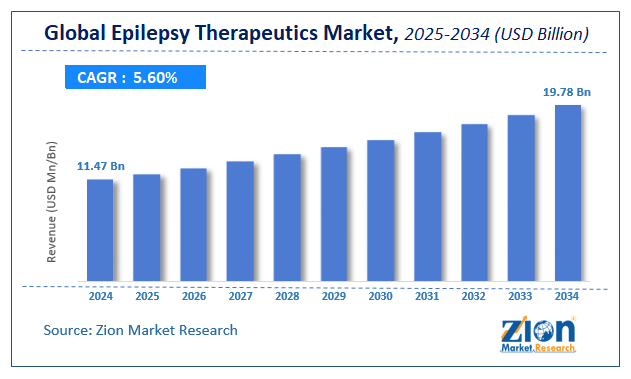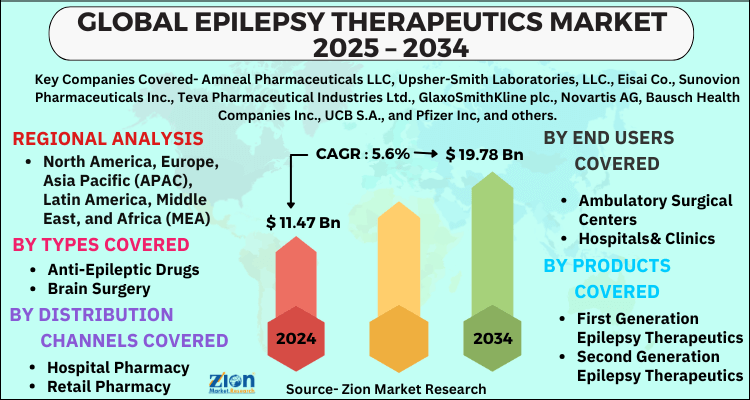Epilepsy Therapeutics Market Size, Share, Trends, Growth and Forecast 2034

Epilepsy Therapeutics Market By Drugs (First Generation Anti-epileptics, Second Generation Anti-epileptics, Third Generation Anti-epileptics), By Distribution Channel (Hospital Pharmacy, Pharmacy Stores, Others), By Location (Rural and Urban), and By Region - Global and Regional Industry Overview, Market Intelligence, Comprehensive Analysis, Historical Data and Forecasts 2025 - 2034
| Market Size in 2024 | Market Forecast in 2034 | CAGR (in %) | Base Year |
|---|---|---|---|
| USD 11.47 Billion | USD 19.78 Billion | 5.6% | 2024 |
Industry Perspective:
The global epilepsy therapeutics market size was worth around USD 11.47 Billion in 2024 and is predicted to grow to around USD 19.78 Billion by 2034 with a compound annual growth rate (CAGR) of roughly 5.6% between 2025 and 2034. The report analyzes the Epilepsy Therapeutics market’s drivers, restraints/challenges, and the effect they have on the demands during the projection period. In addition, the report explores emerging opportunities in the Epilepsy Therapeutics market.
Epilepsy Therapeutics Market: Overview
Epilepsy Therapeutics refers to chronic neurological disorder which causes constant and unfounded seizures. An individual suffering from Epilepsy Therapeutics tends to have seizures with no explanation. In Epilepsy Therapeutics, the brain activity becomes abnormal, resulting in recurrent seizures that are short episodes of involuntary movement, which may involve a part of the body or the entire body. The increase in the number of accidents and brain injuries and the high rate of post-traumatic Epilepsy Therapeutics (PTE) and post-traumatic seizure (PTS) occurrence in patients with brain injuries are the major factors driving the Epilepsy Therapeutics treatment market.
Furthermore, innovation of new treatment products with better efficiency is expected to further drive this market. Rising number of mergers and acquisitions, new product launches, and increasing number of collaborations and partnerships are some of the latest trends that have been observed in the global Epilepsy Therapeutics market. Besides development of new drugs and treatment options, approval and launch of new products extend profitable opportunities to the Epilepsy Therapeutics treatment market players in the forecast period.
In Addition, development of highly efficacious products, having less side-effects, and better outcomes are likely to propel the Epilepsy Therapeutics market Neurological disorders have become a matter of concern for medical researchers who are looking at optimizing medical treatments. Furthermore, the adoption of anti-epileptics due to increasing seizures and Epilepsy Therapeutics cases, and a rise in research and development is driving the growth of Epilepsy Therapeutics market. .However, factors such as lack of awareness about the condition some developing regions and reluctance to adopt Epilepsy Therapeutics medications in some regions are restraining the growth of the Epilepsy Therapeutics market over the upcoming years.
Key Insights
- As per the analysis shared by our research analyst, the global epilepsy therapeutics market is estimated to grow annually at a CAGR of around 5.6% over the forecast period (2025-2034).
- Regarding revenue, the global epilepsy therapeutics market size was valued at around USD 11.47 Billion in 2024 and is projected to reach USD 19.78 Billion by 2034.
- The epilepsy therapeutics market is projected to grow at a significant rate due to rising prevalence of epilepsy, advancements in anti-epileptic drugs (AEDs) and neurostimulation devices, and increasing research and development activities aimed at developing more effective treatments.
- Based on Drugs, the First Generation Anti-epileptics segment is expected to lead the global market.
- On the basis of Distribution Channel, the Hospital Pharmacy segment is growing at a high rate and will continue to dominate the global market.
- Based on the Location, the Rural segment is projected to swipe the largest market share.
- Based on region, North America is predicted to dominate the global market during the forecast period.
Epilepsy Therapeutics Market: Growth Drivers
Active Government Support and Investments to Expedite Market Growth
Governmental initiatives to improve the healthcare sectors and higher investments in R&D is anticipated to expand at a notable growth of Epilepsy Therapeutics market during the forecast period. Rise in the number of approvals by government bodies is providing beneficial for the patients in controlling the seizures. This is projected to fuel the adoption of anticonvulsant and boost the market growth over the upcoming years.
Epilepsy Therapeutics Market: Restraints
Epilepsy Medicine shortage to hamper the market growth
One of the major factors restraining the growth of Epilepsy Therapeutics market during the forecast period is steep rise in medicine shortage. Patients are stockpiling these medicines as there is a shortage of drugs in pharmacies which has raised an alarm in investigating the medicine supply chain globally. This is ultimately affecting the global Epilepsy Therapeutics market as the market becomes less desirable for Epilepsy Therapeutics medications.
Global Epilepsy Therapeutics Market: Segmentation
The global Epilepsy Therapeutics market is segregated based on Product, distribution channel, end-user, and region.
Based on distributional channel, the global Epilepsy Therapeutics market can be segmented into hospital pharmacy, retail pharmacy, and online pharmacy. The hospital pharmacy segment is projected to dominate the global market. growing number of hospitals, along with adequate reimbursement policies provided by these settings, are some of the major factors responsible for higher growth of hospital pharmacy over the upcoming years. This is eventually responsible for the adoption of antiepileptic drugs by the hospital pharmacies globally.
Based on product market has been classified into first generation Epilepsy Therapeutic second-generation Epilepsy Therapeutics and third generation Epilepsy Therapeutics. The second-generation epilepsy therapeutics segment is expected to hold a significant share of the global epilepsy therapeutics. This is due to increased penetration in the market and better effectiveness as compared to first generation Epilepsy Therapeutics
Recent Developments
- In January 2020, Eisai Co. Announced the launch of FYCOMPA in China for the treatment of partial-onset seizures in patients aged 12 years and older.
Epilepsy Therapeutics Market: Report Scope
| Report Attributes | Report Details |
|---|---|
| Report Name | Epilepsy Therapeutics Market |
| Market Size in 2024 | USD 11.47 Billion |
| Market Forecast in 2034 | USD 19.78 Billion |
| Growth Rate | CAGR of 5.6% |
| Number of Pages | 172 |
| Key Companies Covered | Amneal Pharmaceuticals LLC, Upsher-Smith Laboratories, LLC., Eisai Co., Sunovion Pharmaceuticals Inc., Teva Pharmaceutical Industries Ltd., GlaxoSmithKline plc., Novartis AG, Bausch Health Companies Inc., UCB S.A., and Pfizer Inc, and others. |
| Segments Covered | By Drugs, By Distribution Channel, By Location, and By Region |
| Regions Covered | North America, Europe, Asia Pacific (APAC), Latin America, The Middle East and Africa (MEA) |
| Base Year | 2024 |
| Historical Year | 2020 to 2023 |
| Forecast Year | 2025 - 2034 |
| Customization Scope | Avail customized purchase options to meet your exact research needs. Request For Customization |
Regional Landscape
North America dominates the global market for Epilepsy Therapeutics during the forecast period. This is majorly due to higher investments in R&D, increasing awareness and availability of advanced Epilepsy Therapeutics drugs in this region. Moreover, improved healthcare facilities are driving the market for Epilepsy Therapeutics in North America during the forecast period.
Asia Pacific is witnessing a significant growth in the global Epilepsy Therapeutics market over the upcoming years. Due government initiatives in the field, Increased awareness and technological advancement in field is fueling the growth of global Epilepsy Therapeutics market.
Competitive Landscape
Some of the main competitors dominating key players functioning in the global Epilepsy Therapeutics market include.
- BIAL - PORTELA & CA SA
- GlaxoSmithKline Plc
- Johnson & Johnson Services, Inc.
- Novartis AG, Pfizer Inc.
- SanofiSA
- Sunovion Pharmaceuticals Inc.
- UCB SA and Zogenix Inc.
Global Epilepsy Therapeutics market is segmented as follows:
By Types Covered
- Anti-Epileptic Drugs
- Brain Surgery
- Dietary Supplements
- Ketogenic Diet
- Surgical Therapies
By End Users Covered:
- Ambulatory Surgical Centers
- Hospitals& Clinics
- Home Care Settings
- Neurology Centers
By Products Covered:
- First Generation Epilepsy Therapeutics
- Second Generation Epilepsy Therapeutics
- Third Generation Epilepsy Therapeutics
By Distribution Channels Covered:
- Hospital Pharmacy
- Retail Pharmacy
- Online Pharmacy-User
By Region
- North America
- The U.S.
- Canada
- Europe
- France
- The UK
- Spain
- Germany
- Italy
- Rest of Europe
- Asia Pacific
- China
- Japan
- India
- South Korea
- Southeast Asia
- Rest of Asia Pacific
- Latin America
- Brazil
- Mexico
- Rest of Latin America
- Middle East & Africa
- GCC
- South Africa
- Rest of Middle East & Africa
Table Of Content
Methodology
FrequentlyAsked Questions
The global epilepsy therapeutics market is expected to grow due to increasing prevalence of epilepsy and seizure disorders, rising adoption of novel anti-epileptic drugs, growing advancements in neuromodulation therapies, and expanding research into precision medicine and genetic treatments.
According to a study, the global epilepsy therapeutics market size was worth around USD 11.47 Billion in 2024 and is expected to reach USD 19.78 Billion by 2034.
The global epilepsy therapeutics market is expected to grow at a CAGR of 5.6% during the forecast period.
North America is expected to dominate the epilepsy therapeutics market over the forecast period.
Leading players in the global epilepsy therapeutics market include Amneal Pharmaceuticals LLC, Upsher-Smith Laboratories, LLC., Eisai Co., Sunovion Pharmaceuticals Inc., Teva Pharmaceutical Industries Ltd., GlaxoSmithKline plc., Novartis AG, Bausch Health Companies Inc., UCB S.A., and Pfizer Inc, among others.
The report explores crucial aspects of the epilepsy therapeutics market, including a detailed discussion of existing growth factors and restraints, while also examining future growth opportunities and challenges that impact the market.
List of Contents
Industry Perspective:OverviewKey InsightsGrowth DriversActive Government Support and Investments to Expedite Market GrowthRestraintsEpilepsy Medicine shortage to hamper the market growthSegmentationRecent DevelopmentsReport Scope Regional LandscapeCompetitive Landscape Global market is segmented as follows:By Distribution Channels Covered:By RegionRelatedNews
HappyClients
Zion Market Research
Tel: +1 (302) 444-0166
USA/Canada Toll Free No.+1 (855) 465-4651
3rd Floor,
Mrunal Paradise, Opp Maharaja Hotel,
Pimple Gurav, Pune 411061,
Maharashtra, India
Phone No +91 7768 006 007, +91 7768 006 008
US OFFICE NO +1 (302) 444-0166
US/CAN TOLL FREE +1 (855) 465-4651
Email: sales@zionmarketresearch.com
We have secured system to process your transaction.
Our support available to help you 24 hours a day, five days a week.
Monday - Friday: 9AM - 6PM
Saturday - Sunday: Closed






